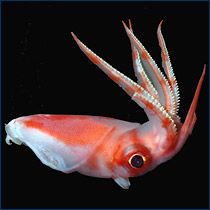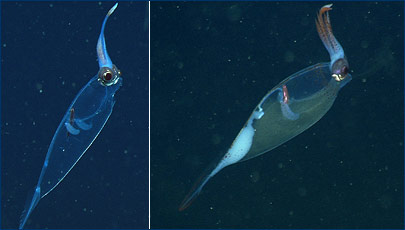
Stephanie cruising for squid on the deck of the research vessel, the Western Flyer.
Squid science: Field notes from Stephanie Bush
 Stephanie cruising for squid on the deck of the research vessel, the Western Flyer. |
Stephanie does much of her work at the Monterey Bay Aquarium Research Institute (MBARI), using ROVs to plumb the depths of the underwater Grand Canyon that bisects the Bay. On these cruises, Stephanie mans the NASA-style control room onboard, while the ROV takes the dive, sending video back to the boat. Says Stephanie: "Most of what you see is the opening to Star Wars. It's just blackness with white spots coming at you, which are particles in the water …. Eventually, we'll spot something off in the distance. And at this point, I can usually tell what it is. We basically just drive around until we find what we want." And in Stephanie's case, what she "wants" are squid — deep-sea dwellers that may never approach the illuminated surface of the sea.
 At left, the remotely operated vehicle (ROV) Ventana is launched from the research vessel Point Lobos in Monterey Bay. At right, the ROV control room on board the Point Lobos. |
 Octopoteuthis deletron, one of the Monterey Bay squid species that Stephanie studies. |
To add to the mystery, deep-sea octopus species (in contrast to their shallow-water cousins) have all evolved reduced, vestigial ink sacs or have lost them entirely through evolution — presumably because inking in the deep sea wasted energy and provided no survival advantage. This leads us to an evolutionary conundrum. Inking was not advantageous to octopus species that evolved to live in deeper waters and so they lost the ability to ink, but the same is not true for squid. Squid species that evolved to live in deeper waters have all retained the ability to ink, suggesting that inking is somehow advantageous to them. But how? This is the puzzle that Stephanie hopes to unravel.
Solving that mystery won't be easy. There are many plausible hypotheses to explain how inking could be advantageous to deep-sea squid. Despite the extremely low light levels, inking could still offer the same visual protection that it may near the surface — since squid and many of their deep sea predators have large, sensitive eyes and might be able to detect shapes in quite dim light. It's also possible that the ink serves as a sort of "cloaking device": as animals move through the deep sea, they stir up tiny bioluminescent organisms which release glimmers of light. Perhaps the ink hides a squid's bioluminescent jet trail. Or maybe, the secret of the ink is not in its color, but in the chemicals it contains. Perhaps other deep sea organisms sense those chemicals in the water, just as we identify smells in the air. Perhaps the ink somehow attracts mates to a lonely squid. Or maybe it attracts prey. Or maybe, the chemicals in the ink deter predators. To complicate things even further, squid release ink in different ways, sometimes producing diffuse smokescreens or clouds, sometimes viscous blobs, and sometimes long ropes. These different sorts of ink could serve different functions.
|
At left, Dosidicus gigas creates a cloud of ink. Note that the funnel is aimed upward while releasing ink, then downward to move the animal up into the ink cloud. At right, the squid Gonatus onyx makes his escape after releasing a pseudomorph (a dense blob of ink the approximate size and shape of the squid itself). See more squid videos on the MBARI website. |
||
|
What makes a squid's ink black? The chemical melanin — the same pigment in your own skin that allows you to tan. |
With all of these possibilities, how will we ever figure out which hypothesis (or which combination of hypotheses) is the best explanation for deep-sea squid inking? In science, all ideas must be tested against multiple lines of evidence from the natural world. Stephanie is beginning her studies with two main lines of evidence. First, she'll study how potential predators and other squid react to the ink. In a lab lit only by red light (which is invisible to some deep-sea organisms), she'll release squid ink near the animals and film their reactions. Do they lunge at it? Are they offended by it? Or do they ignore it completely? She's also trying to outfit one of the ROV arms with a sort of robotic turkey baster that would let her release ink near animals in the deep sea to test their reactions in their natural habitats. Second, Stephanie plans to run chemical analyses on her squid ink to help figure out if any of its components are deterrents or attractants. She admits to being "not much of a chemist" — yet, at least. She's planning to team up with other scientists to help her disentangle the ingredients that make up squid ink.
The investigation is just beginning, and Stephanie is not sure where it will lead: "I've thought about it a lot, of course, but I don't really know what to expect. I feel like there's probably a chemical component, but that's just because I can't explain how a solely visual ink in the deep sea would work."
 At left, the body of the transparent squid Galiteuthis shows no sign of ink inside. In the Galiteuthis at right, ink is visible. |
Dig deeper
To learn more about Stephanie's previous research, see these papers:
Bush, S.L., and B.H. Robison. 2007. Ink utilization by mesopelagic squid. Marine Biology 152:485-494. ![]()
LaJeunesse, T.C., Lee, S., Bush, S.L., and Bruno, J.F. 2004. Persistance of non-caribbean algal symbionts in Indo-Pacific mushroom corals released to Jamaica 35 years ago. Coral Reefs 24(1):157-159. ![]()
Bush, S.L., Precht, W.L., Woodley, J.D., and Bruno, J.F. 2004. Indo-Pacific mushroom corals found on Jamaican reefs. Coral Reefs 23(2):234. ![]()
Also, check out Stephanie's webpage.
Photo of ROV control room © 2006 MBARI; launching the ROV from the Point Lobos by Kim Fulton-Bennett © 2004; both movie clips © MBARI; Galiteuthis with no ink © 2005 MBARI; Galiteuthis with ink © 2003 MBARI; Octopoteuthis deletron by Stephanie Bush.